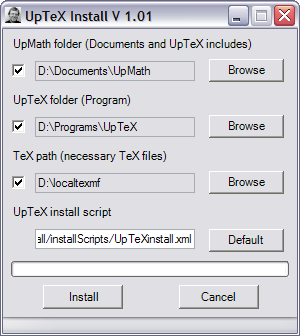

|
If you like to be informed about updates, please contact us informally. But note that there are a lot of changes during this first stage of development.
Use the contact form or send
email to upmath at mathematik.uni-marburg.de.
|
To use UpTeX you need a working LaTeX environment. This installation of UpTeX is designed for MiKTeX and offers optional WinEdt (a convenient shell) support. If you are already using a different LaTeX system or want to do so, please contact us for information on using UpTeX with it.
The UpTeX Installer is as well install software as update software for UpTeX. To run it you need the Microsoft .NET Framework Version 1.1 or higher. If you are using Windows (98, ME, NT, 2000, XP or higher) and have installed all updates you should already have it. Just execute UpTeX Install.exe to find out.
If you already have a local TEXMF tree, please note that we create a new pdftex.cfg file. If you have changed this file on your system and want to keep it, make a backup of this file and copy the changes to the new one. Keep in mind that this happens every time you select localtexmf tree when installing UpTeX.
Due to temporary incompatibilities we strongly recommend using this version of MiKTeX, not
the most recent one. Just extract all files from the ZIP file, which has a size of 250 MB, to a temporary
directory and run setup-2.4.1445[1].exe Select the total package set (size on disc 500 MB) for
installation. Later during the installation process the setup software will recommend you to create a
As an editor for your UpTeX documents you may want use the shareware WinEdt. You can download it here, installation instructions can be found on the same page.
This is what you should see after successfully launching UpTeX Install:

The
The
The
In the
When you have selected locations for the folders make sure your PC is connected to the internet and press the Install button. The software will now attempt to download about 300 KB of data. You can contact us if you get error messages over a longer period of time. After a successful Installation an according message is being displayed.
Now you should tell MiKTeX about the new files: start MiKTeX Options from the MiKTeX folder in the
Start menu. You see a text saying "File name database - Refresh the file name database when you have
installed new packages or font files." Click the button
After complete installation you can open demo.utx from the UpMath folder and test your UpTeX installation.
For the WinEdt shell we provide a macro you can use to conveniently generate PDF files from UpTeX
documents. Click on
To add UTX to WinEdt's known file types click